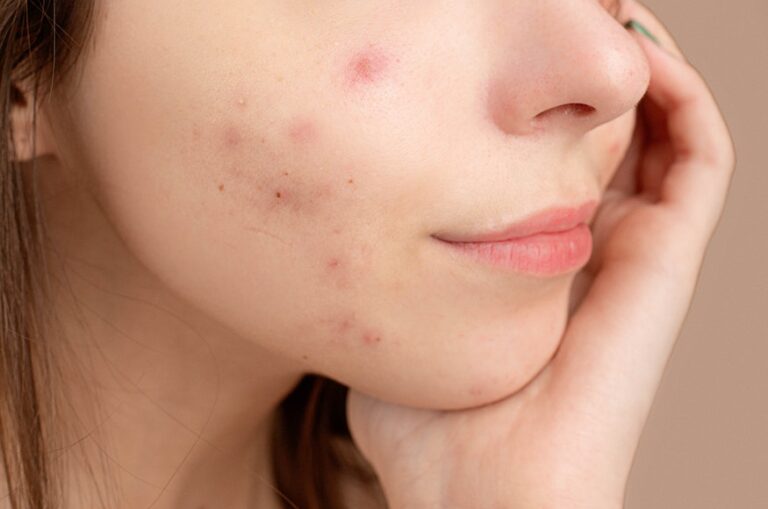Pimples are caused by clogged hair follicles that produce oil, or sebum. As boys and girls go through puberty, sex hormones cause these glands to produce more sebum. This irritates the skin and can lead to infection.
While masturbation and sexual activity do trigger changes in hormones, these are temporary and not linked to acne breakouts.
Causes
As a teenager, you may have been told by older generations that masturbating or having sex causes acne. Whether or not this was a scare tactic to get you to stay away from those sexual urges, there is no scientific evidence that this is the case. Acne is caused by many factors, including hormones, food, stress, and skin products.
During puberty, the sex hormone testosterone increases and the oil glands begin to produce sebum, which can cause inflammation and lead to pimples. Sexual activity can also increase hormones that stimulate secondary sexual characteristics, such as the development of facial hair or a deeper voice. The friction of rubbing against a partner’s face hair can irritate the skin and encourage the production of excess oil. The clogged pores of the hair follicles can then spill over into the surrounding skin, creating an acne-like lesion.
Sometimes these spots are nothing to worry about; however, some bumps and lumps can be a sign of an infection or a serious health condition. If you notice a change in the color, size or shape of any blemishes on your face, make an appointment with a doctor right away.
Some of the sex-related bumps on your face may be angiomas or cysts, which are small, harmless collections of blood vessels. They usually look bright red or purplish and don’t bleed. Larger bumps that resemble pimples might actually be boils or cysts, which are a type of bacterial infection.
Symptoms
There are a few reasons why you might have acne after sex. One is that the sweat produced during sex makes your skin oily. This oil then clogs your pores and you get breakouts. Using massage oils or creams can also cause this. The problem is that they are not suited for the sensitive skin on your face, neck or back and can actually make the situation worse.
Another possibility is a viral infection called molluscum contagiosum, which can show up as bumps or growths. The infection is usually harmless, but it can spread to others through close contact. You might see a few hard, round bumps near your genital area or on the thighs, arms, torso and neck. The bumps look like pearls and can range in color from white to pink or purple. They may also have a tiny dent or dimple in the center.
The good news is that the bumps are usually not painful and they go away on their own. If you are concerned about any new symptoms, however, talk to your health care provider. They can run tests to confirm the diagnosis and get you started on treatment, if necessary. They can also help you with prevention to protect yourself and your partners from any possible sexually transmitted diseases that you might have picked up.
Treatment
Nothing spoils the blissful afterglow of a good romp like waking up to discover a big ol’ pimple in the area you thought was clear. It might be that you have a condition that affects the skin where you shave, or maybe a new soap or shampoo you started using. But it could also be the result of sexually transmitted infections.
Fordyce spots: These little bumps, which are genetic and appear in areas where oil glands are present but not hair follicles, are common on the lips, but can show up around the genitals as well. They can grow larger during puberty, when the oil glands become active. They don’t need treatment and often go away on their own.
Molluscum contagiosum: These raised papules are painless and look pink, white, or flesh-colored. They spread through non-sexual skin-to-skin contact and are more common in children, sexually active adults, and people with suppressed immune systems. They usually clear up on their own, but may require treatment. Your healthcare provider may apply a cream or liquid to the lesions to help reduce irritation, or freeze them with liquid nitrogen.
Bumps that resemble acne near the vulva can be caused by clogged pores, ingrown hairs, or genital warts caused by human papiloma virus, or HPV. You can prevent them by practicing good hygiene, showering regularly and wearing loose-fitting clothing; avoiding tatoos and body piercings; and getting regular Pap smears and HPV tests.
Prevention
There’s a popular belief that sex and masturbation cause acne, but this is false. Masturbation doesn’t increase your hormone levels enough to trigger an acne outbreak, and it certainly does not make existing acne any worse. Rather, acne is mostly caused by the skin’s oil glands, which are overstimulated during puberty by high levels of androgens (male sex hormones). These hormones overstimulate the sebaceous glands, and when combined with bacteria, clog pores that are already inflamed and prone to infection.
In addition to avoiding sex in unsanitary conditions, there are other ways you can prevent sex bumps on your face. Wash your face regularly to keep it free of oil, dirt and other impurities that can clog pores. You should also avoid using hair products that contain oils, as they can transfer onto the skin and cause an acne breakout.
Another way to avoid sex bumps is to take precautions against the molluscum contagiosum virus. This infection, which can be seen as tiny, round and firm bumps ranging from a pinhead to a pencil eraser, spreads through skin-to-skin contact with an infected person. It’s most common in children, and it can also spread through sharing clothes, towels and toys. You can prevent molluscum contagiosum by washing your hands often, covering any areas where you have it with clothing and not touching the bumps.
See Also:



